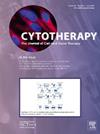Impacts of transient exposure of human T cells to low oxygen, temperature, pH and nutrient levels relevant to bioprocessing for cell therapy applications
IF 3.7
3区 医学
Q2 BIOTECHNOLOGY & APPLIED MICROBIOLOGY
引用次数: 0
Abstract
Background
T-cell therapy advances have stimulated the development of bioprocesses to address the specialized needs of cell therapy manufacturing. During concentrated cell washing, the cells are frequently exposed to transiently reduced oxygen, temperature, pH, and nutrient levels. Longer durations of these conditions can be caused by process deviations or, if they are not harmful, be used to ease the scheduling of process stages during experiments as well as manufacturing.
Methods
To avoid unpredictable impacts on T-cell quality during bioprocessing, we measured the influences of such environmental exposures generated by settling 250 million activated human T cells per mL, for up to 6 h at temperatures from 4 to 37°C.
Results
The measured glucose concentration decreased to as low as 0.5 mM and the pH to 6, while lactate increased up to 55 mM. The concentrated cell conditions at 37°C resulted in by far the greatest losses in viable cell numbers with, on average, only 58% and 41% of the cells recovered after 3 and 6 h, respectively. Likewise, their subsequent cell expansion cultures were substantially reduced even after only 3 h of exposure, and with decreased percentages of central memory T cells and increased percentages of effector memory and effector T cells. Although under similar environmental conditions at room temperatures, the negative impacts of high cell concentrations were greatly diminished for up to 3 h. At 4°C the transient conditions were less extreme, and the cells well maintained for 6 h.
Conclusions
Overall, when developing processes and devices for T-cell therapy manufacturing that involve concentrated cells, the results of this study indicate that more practically feasible room temperatures can be used for up to 3 h to obtain high viable cell recoveries whereas lower temperatures such as 4°C should be used if there is a need for more prolonged concentrated T-cell conditions.
求助全文
约1分钟内获得全文
求助全文
来源期刊

Cytotherapy
医学-生物工程与应用微生物
CiteScore
6.30
自引率
4.40%
发文量
683
审稿时长
49 days
期刊介绍:
The journal brings readers the latest developments in the fast moving field of cellular therapy in man. This includes cell therapy for cancer, immune disorders, inherited diseases, tissue repair and regenerative medicine. The journal covers the science, translational development and treatment with variety of cell types including hematopoietic stem cells, immune cells (dendritic cells, NK, cells, T cells, antigen presenting cells) mesenchymal stromal cells, adipose cells, nerve, muscle, vascular and endothelial cells, and induced pluripotential stem cells. We also welcome manuscripts on subcellular derivatives such as exosomes. A specific focus is on translational research that brings cell therapy to the clinic. Cytotherapy publishes original papers, reviews, position papers editorials, commentaries and letters to the editor. We welcome "Protocols in Cytotherapy" bringing standard operating procedure for production specific cell types for clinical use within the reach of the readership.
 求助内容:
求助内容: 应助结果提醒方式:
应助结果提醒方式:


